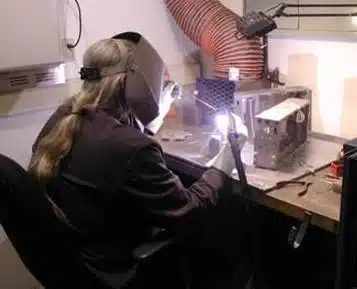
Castings are susceptible to having small discontinuities such as inclusions, voids, cracks, etc. that are cosmetically unappealing or potentially even a cause of end product failure. In-process weld rework of castings, sometimes also referred to as “cosmetic weld repair”, is a routine and commonplace foundry activity that is used to mend such casting discontinuities. A casting that has been welded and blended will be dimensionally, physically, chemically and metallurgically compliant to drawing requirements.
Foundry customers derive both direct and indirect benefit from weld rework as it helps make castings more affordable and improves foundry on-time delivery. Foundries factor a casting-yield in their production runs which is an allowance for some quantity of scrap. A poorer than predicted yield of castings will jeopardize a customer delivery, burden the foundry with the cost for the unanticipated scrap, and also the additional expense for a re-run of parts. In-process weld rework provides a foundry with an opportunity to salvage parts that might otherwise be scrap and so protect the customer delivery. Foundries won’t perform unnecessary amounts of weld rework as the cost can easily exceed the value of a casting. In effect weld rework stabilizes foundry yields which, in turn, improves the delivery and the overall affordability of a casting.
The practice for in-process weld rework is well established and presents no deleterious risk to the quality of a casting. A properly performed weld, because of its rapid solidification, is likely stronger than the base metal of the casting.* If you think about it prosaically, the welding of a casting is essentially a “local re-liquefaction” of something that was formerly all liquid.
For the heat treatable alloys to be metallurgically compliant the weld rework of castings must be performed prior to any heat treatment. Post treatment welding will destroy the effect of the heat treatment and so is often called “green welding”. Green welding should only be conducted with the express written permission of the customer.
Weld rework of commercial castings is generally performed by foundries without reservation. Military and aerospace drawings, however, are likely to contain an AMS or ASTM material specification that will prohibit weld rework of castings without first having written customer authorization. Drawing notes are frequently used to convey the required permission to the foundry. In instances where an in-process weld authorization is not automatically being flowed a foundry should identify this at contract review issue and formally request a rework authorization from its customer.
Welding of castings should be referred to as an in-process weld “rework” instead of “repair”. In aerospace and perhaps in other industries as well, the word “Repair” alludes to a very specific and closely controlled activity. Unfortunately, the foundry industry does often identify the procedure as a “Weld Repair”. In aerospace vernacular an in-process weld rework being performed prior to heat treatment it is not considered to be a “Repair” and use of the term should be discouraged.
The most commonly referenced specification for the weld rework of investment castings is AMS2694. Titled “In-Process Welding of Castings” the “Purpose” of AMS 2694 is to define “the requirements for in-process correction of foundry discontinuities by manual welding of castings.” A discontinuity is further defined as a casting nonconformance such as a crack, damage, hot tear, cold shut, shrinkage, porosity, gas hole, inclusion, etc. Weld rework may not be used to correct dimensional discrepancies, discontinuities found during machining, or to fabricate portions of castings unless specifically authorized by a customer. AMS2694 requires that weld rework must be performed by qualified welders and that the welds must be blended and inspected to the requirements of the drawing. Residual linear indications are never acceptable.
In-process weld rework is a routine foundry operation that enhances the affordability and delivery of cast products. If you have any questions concerns regarding weld rework please contact your O’Fallon Casting Sales Engineer.
*There are a number of studies that attest to this fact. See Paper presented by Authors Gerald Gagel, Daniel Hoefert, Joseph Hirvela, & Randy Oehrlein at AFS CastExpo 2013 on the “Effect of Weld Repair on Static and Dynamic Tensile Properties of E357-T6 Sand Castings” and concludes that the researchers found that “…repair welding had no detrimental effects on tensile or fatigue properties.”
